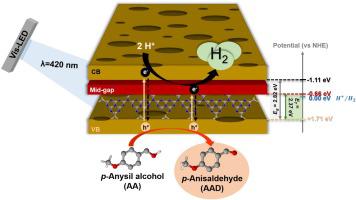Applied Catalysis A: General ( IF 4.7 ) Pub Date : 2020-11-05 , DOI: 10.1016/j.apcata.2020.117912 Raquel A. Fernandes , Maria J. Sampaio , Eliana S. Da Silva , Hanane Boumeriame , Tânia Lopes , Luísa Andrade , Adélio Mendes , Joaquim L. Faria , Cláudia G. Silva

|
Citric acid-modified graphite-like carbon nitride materials (GCN-zCA) were synthetized by thermal co-polymerization of dicyandiamide with different amounts of citric acid (z = between 5 and 25 mg). The resulting materials presented surface porosity, defective polymeric structure, and enhanced visible light absorption in the 450−700 nm range, attributed to the existence of mid-gap states and n-π* electronic transitions. All the modified catalysts presented high selectivity (>99 %) towards the conversion of p-anisyl alcohol into p-anisaldehyde under visible-LED irradiation, the best performing photocatalyst (GCN-20CA) reaching 63 % yield (contrasting with 22 % obtained with bulk GCN) after 240 min reaction. GCN-20CA was also applied for hydrogen generation from water splitting. The modified material practically duplicated the hydrogen production when compared to bulk GCN (75 and 44 μmol H2 evolved in three hours, respectively), by using platinum nanoparticles as co-catalyst and EDTA as sacrificial electron donor. Moreover, p-anisyl alcohol was successfully used as sacrificial agent for water splitting, with simultaneous production of p-anisaldehyde and H2. Reusability tests showed that GCN-20CA remained stable in a series of consecutive runs both for p-anisaldehyde synthesis and hydrogen production.
中文翻译:

通过使用柠檬酸改性的氮化碳光学半导体可持续生产增值化学品和燃料
柠檬酸改性的类石墨氮化碳材料(GCN- z CA)是通过双氰胺与不同量的柠檬酸(z = 5至25 mg)进行热共聚而合成的。所得材料在450-700 nm范围内表现出表面孔隙率,不良的聚合物结构和增强的可见光吸收,这归因于存在中间能隙态和n-π *电子跃迁。所有的改性催化剂都表现出高的选择性(> 99%),可以将对-茴香醇转化为对位-茴香醛在可见光LED的照射下,反应240分钟后,性能最佳的光催化剂(GCN-20CA)达到63%的收率(相比之下,本体GCN获得22%)。GCN-20CA还用于水分解制氢。与本体的GCN(分别在三个小时内释放出75和44μmolH 2)相比,通过使用铂纳米粒子作为助催化剂和EDTA作为牺牲电子供体,改性材料实际上复制了氢气的产生。此外,对茴香醇成功地用作水分解的牺牲剂,同时生产了对茴香醛和H 2。可重用性测试表明,GCN-20CA在一系列连续运行中均保持稳定对茴香醛的合成和制氢。











































 京公网安备 11010802027423号
京公网安备 11010802027423号